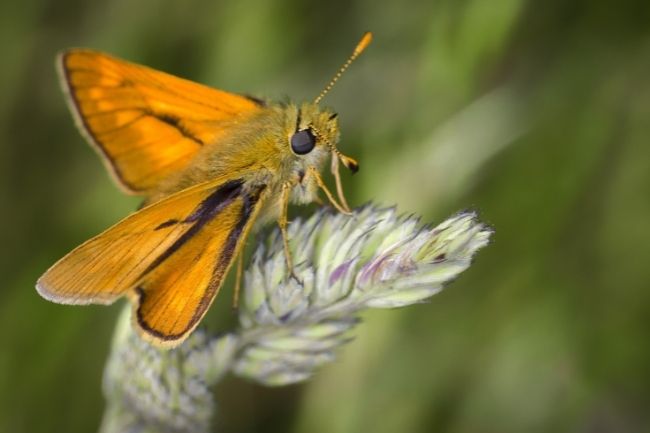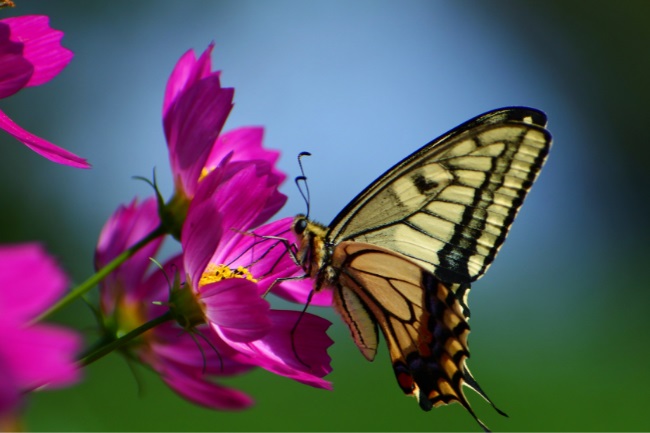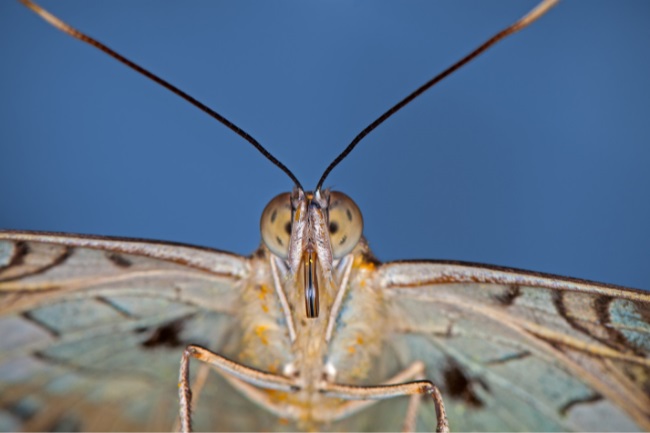Moths and butterflies are both Lepidoptera and therefore have many similar features. It is hard to find clear defining features that separate them, but moths tend to have feather-like antennae, while butterflies have club-shaped antennae.
Contents
Are moths a type of butterfly?

As humans, we like to be able to divide up and categorise the world. This helps us to understand the very complex environment that surrounds up, and make decisions based on what we’ve discovered.
However, when it comes to nature, things aren’t always as clear-cut as we would like to make them. While we like to say that all birds can fly and all fish can’t, there are many birds that don’t, and some fish that give it a good go.
The differentiation between moths and butterflies is similar to this. Both moths and butterflies are Lepidoptera, meaning they share many similar characteristics, such as their scale-covered wings, chemical detecting antennae and a lifecycle that involves going through a full metamorphosis.
While we wouldn’t say that moths are a type of butterfly, there are a great deal more of them than there are butterflies, with over 160,000 moth species globally, and only around 18,000 butterflies. If anything, we would have to say butterflies are a type of moth.
Also read: Moths Reproduction Explained (Larvae, Eggs,…)
Differences between moths and butterflies

There are a number of rules of thumb you can use to help you divide moths and butterflies, however, few of them are completely reliable when it comes to consistently dividing up the two groups, as there are often exceptions to the rule.
| Characteristic | Moths | Butterflies |
|---|---|---|
| Antennae | Typically feathery or filamentous | Generally clubbed or knobbed |
| Body Shape | Thick and plump | Slender and streamlined |
| Wing Position | Rest with wings open, flat, or folded | Rest with wings closed, held upright |
| Wing Patterns | Dull and cryptic colors | Bright and vibrant patterns and colors |
| Flight Behavior | Typically fly at night | Primarily active during the day |
| Resting Habits | Rest on vertical surfaces | Rest on horizontal surfaces |
| Stage | Moths | Butterflies |
|---|---|---|
| Pupae Appearance | Usually enclosed in a silk cocoon | Encased in a chrysalis |
| Pupation Duration | Generally longer pupal stage | Usually shorter pupal stage |
| Larval Habitats | Wide range of habitats and food plants | Specific host plants for each species |
| Adult Lifespan | Typically shorter lifespan | Generally longer lifespan |
| Mating Behavior | Males usually locate females by scent | Males actively pursue females in flight |
| Reproductive Rate | Often higher reproductive capacity | Typically lower reproductive capacity |
| Aspect | Moths | Butterflies |
|---|---|---|
| Species Diversity | Greater number of moth species | Fewer species of butterflies |
| Habitat Range | Found in a wide range of habitats | Tend to prefer specific ecosystems |
| Pollination Role | Primarily nocturnal pollinators | Diurnal pollinators |
| Food Preferences | Some feed on nectar and pollen | Generally feed on nectar |
| Economic Impact | Some species considered pests | Often celebrated for their beauty |
| Cultural Symbolism | Less commonly associated with symbolism | Symbolic significance in many cultures |
Active times
There is a common misconception that all moths fly at night and all butterflies fly in the daytime. While the vast majority of moths do fly at night, there are also a large number of species that fly in the day or are crepuscular, meaning they fly at dawn and dusk.
In the UK, for example, there are more day-flying moth species than there are butterfly species. The cinnabar moth, for example, is often mistaken for a butterfly as not only does it fly during the day, but it is brightly coloured with brilliant scarlet reds complimenting its general black colouring.
However, while there are many moths that do fly during the day, there are few butterflies that fly at night. The owl butterfly is one exception. While it does not fly in the middle of the night, it is most active at dusk, resting during the day. Its large eyespots give it its name, and make it appear like the face of an owl if disturbed.
Antennae

One of the most reliable ways to tell moth and butterfly species apart is their antenna. Antennae are appendages that sit on the heads of insect species. They are highly important sensory organs, able to detect a wide range of chemicals, as well as helping the insect to touch objects, communicate through moving their antennae, and even sense other climatic conditions such as temperature and humidity.
Butterflies and moths use their antennae to pick up chemicals, which can tell them where food can be found, where mates are located and even if predators are nearby. Antennae size and shape vary a great deal between different species, however, in general moths possess plumose antennae, meaning their form is feathery. Larger, more plumose antennae tend to be found more within the males, with females usually having smaller and simpler versions.
Butterflies by comparison tend to have club-shaped antennae, meaning they are long and thin with a small bobble on the end. The reason for this marked difference may be that most moth species are active at night, and so can rely less on their sight to locate what they need, and therefore may need their sense of smell/taste more.
There are some exceptions to the rule, however, such as the six-spot Burnet moth, which has club-shaped antennae. This may be because it is a day-flying moth.
Also read: How Butterflies Taste? With Feet, Antenna or Tongue?
Body shape
This is another tricky one, as again it isn’t always reliable. In general, moths have bigger, chunkier bodies covered in larger amounts of hair. Without their wings, they would look more like a fluffy little mammal than an insect.
Butterflies are also usually covered in hair, but generally not as much as their moth cousins. These bodies also tend to be more slender and delicate. It may be that as moths are active at night, they need larger bodies to retain heat and keep active.
Resting wing shape
Resting wing shape is also an interesting one. Usually, butterflies like to rest with their wings pressed together, pointing upwards above their bodies. Moths on the other hand have their wings open, horizontal to their bodies.
However, to confuse matters, butterflies can often be seen basking. Basking is a method these heat dependent insects use to warm up in the sun so they can heat up their flight muscles. And again, not all species comply to the rules even when resting. Skipper butterflies look rather like little paper aeroplanes when at rest, something halfway between what we would expect of a butterfly and a moth.
Some moth species also play by their own rules, like the geometrid moth species, such as the yellow thorn moth. These again hold their wings out more at 45 degrees.
Cocoons
Both moths and butterflies go through complete metamorphosis. This means that they change completely from their larval forms into their adult ones. In order to complete their metamorphosis, they change into a pupa or chrysalis. While we tend to think of the chrysalis as something the butterfly or moth enters into, it is actually the exoskeleton of the insect, not a separate casing.
The majority of species use silk in their metamorphosis in some way. This may be to attach themselves to a branch, or to the underside of a leaf, but this is usually just in the form of a few strands. We only tend to apply the word ‘cocoon’ when the silk is spun into an almost complete structure around the pupa.
A cocoon can help to hide the pupa, or keep it warm, or even shelter it from damage. The most famous cocoon spinner is the silk moth caterpillar, whose cocoon has been harvested for thousands of years to weave silk. While not all moth species spin cocoons, the vast majority do, while butterflies do not.
Also read: Moths & Lights – Why Do They Attract Them?
Frenulum
To get even more technical, moths have something called a frenulum, which butterflies lack. Both butterflies and moths have four wings, however, moths have essentially altered their anatomy so they effectively only have two wings. This is because the frenulum, or wing coupling, joins the front and back wings together, so they must move as one.
This changes the way in which they fly and may make flying more energy efficient while sacrificing some of their manoeuvrability. This may be less of a sacrifice to the many moth species that fly at night, whereas day-flying butterflies may need to worry more about escaping from the many predators who can easily spot them fluttering about.
Moth and butterflies: A force for good
When you get down to it, there isn’t a great deal of difference between moths and butterflies. In fact, the biggest difference probably exists in our minds. Culturally, we are much more in favour of butterflies than moths. We praise butterflies for their beauty and grace, while we are far more likely to think of moths as frightening and peculiar.
Yet both are important pollinators, and species we should want to see more of. Even when it comes to beauty, there are many stunning looking moths, such as the pink and green elephant hawkmoth, or the delicate green luna moth.
There may even be many moths that we praise as butterflies, due to their day-flying habits. This moth snobbery is an unfortunate repercussion of our wish to divide up the natural world, and often even label some elements as good and others as bad.
Perhaps one day we will be able to measure moths and butterflies more equally and realise they aren’t so different after all

